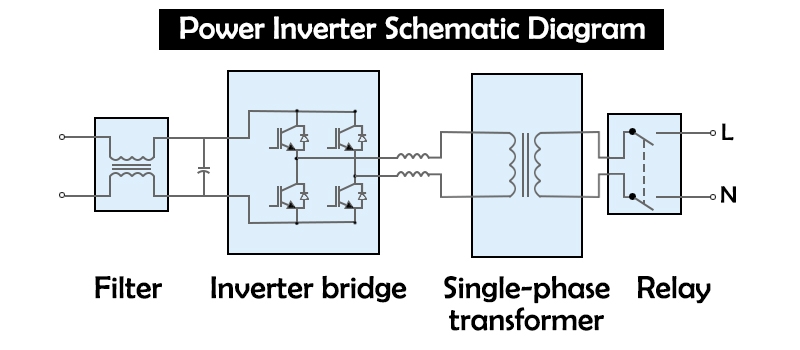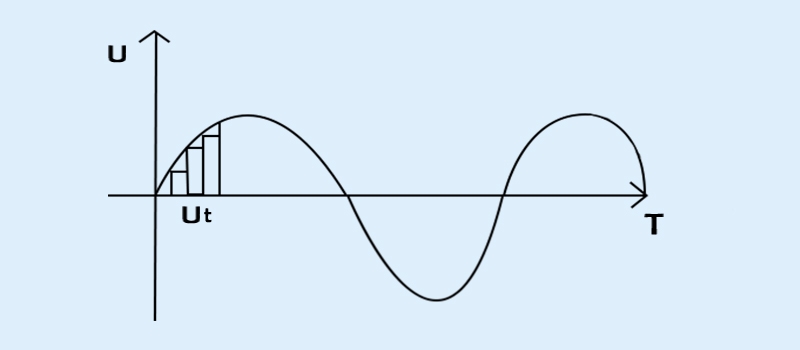Inverter refers to a device that converts direct current to alternating current. Power inverters are commonly used in power systems such as photovoltaic, wind power, and uninterruptible power supply (UPS). They provide a stable output voltage and frequency, protect connected equipment from power fluctuations, and can also regulate energy according to load demand and grid demand. How does a power inverter fulfill these functions? PowerHome will introduce how it works.
Working Principle of Power Inverter
Inverters control the direction and magnitude of current through a series of semiconductor switches (e.g., transistors, MOSFETs, IGBTs, etc.) to convert DC to AC. These switches open and close at a very high rate in response to a control electrical signal to produce AC power at the output. Modern power inverters usually also include some filtering and control systems to ensure the quality and stability of the output power. In most cases, it performs 60 times per second, which is a frequency of 60 Hz.

Working Process
1. DC Input: The power inverter receives power from batteries, photovoltaic panels or other DC sources.
2. Rectification: The power inverter converts the incoming DC power into alternating pulsed signals by means of a bridge rectifier. The bridge rectifier consists of four diodes that are used to achieve unidirectional conduction and allow current to pass between the two AC outputs.
3. Filtering: After conversion to alternately varying pulse signals, the inverter converts the pulse signals into a smooth DC power supply by means of a filter. The filter is mainly composed of inductors and capacitors. By filtering signals of different frequencies, the filter achieves the purpose of removing pulse signals and stabilizing the output current.
4. Voltage and Frequency Regulation: After being converted to DC power by the filter, the inverter converts the DC power to AC power. The inverter is actually an alternating current source, which switches the direction of the current through high-frequency switching devices (e.g., MOSFETs, IGBTs, etc.) to generate AC power.
The control circuitry in the inverter adjusts the output voltage and frequency to meet the needs of a particular application. This is usually accomplished through PWM (Pulse Width Modulation) technique, where the output voltage is controlled by varying the pulse width. SPWM is one of the more mature techniques, which can be used to fit the output RMS value of the H-bridge to a sinusoidal increase curve by calculating the value of the PWM duty cycle of the control H-bridge over time.
The sine wave image is shown below:

5. AC Output: The output of the inverter is connected to the load device. Various load devices such as household appliances, industrial equipment, etc. can be supplied by the AC current output from the inverter. The parameters (voltage, frequency, waveform) of the inverter output current are adjusted according to the needs of the application.
Special Functions of Power Inverter
-
Grid Interaction: For grid-connected inverters, they need to be able to synchronize with the utility grid, which means that the output voltage and frequency must be perfectly matched to the grid's voltage and frequency. In addition, the inverters need to be able to automatically disconnect in the event of a grid fault to protect both the user and the grid. Off-grid inverters, on the other hand, are not restricted by the grid, enhancing convenience.
-
Energy Management: Power inverters also play a role in energy management in renewable energy systems, such as automatically adjusting output power according to load demand, or storing and releasing energy according to grid demand.
-
Protection and Control Systems: Inverters are often equipped with a variety of protection and control systems, such as overload protection, overheating protection, and short-circuit protection, to ensure that the power inverter can safely power your home and extend its lifespan.
-
Communication and Monitoring: Modern inverters usually have the ability to communicate with higher level control systems for remote monitoring and management.

To summarize, the working principle of power inverter is to convert the DC power source into smooth DC power source through the processing of bridge rectifier and filter, and then through the high-frequency switching device of inverter for the output of alternating current, and finally connect the load equipment to supply electric power.
Power inverters are widely used in modern society in the field of renewable energy such as solar energy, wind energy and other renewable energy sources, as well as in the field of household electricity, industrial machinery, etc., which provide convenience and convenience for people's production and life.
(1).png)
(1).png)